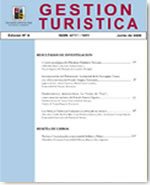THE GROWTH OF THE TOURISM SECTOR IN MEXICO 2004-2017
Main Article Content
Abstract
This article aims to analyze the growth of Mexico's tourism activity through basic variables such as the annual average growth rate, the total revenue generated by tourism, the contribution of the tourism subsector to the tertiary sector, the gross tourist value added, tourism employment and the composition of tourism GDP.
Tourism in Mexico is one of the main generators of foreign exchange that, in 2018, was located only after remittances and before the export of hydrocarbons. In the last 10 years alone, these increased by 185%, amounting to US $11.5 billon ; In addition, the arrival of tourists has also doubled (204%) over the same years to 19.3 million; and as a result, the tourism sector grows at an average annual rate of 2.9%, which is 0.6% higher than the average growth rate of the national economy which is 2.3%.
In methodological terms, the analysis of the dynamics and evolution of the growth of the sector, is structured under a logical-deductive and descriptive view based on the choice of basic variables selected and systematized by the National Institute Statistics and Geography (INEGI).
The content is distributed in four sections; the first addresses the theoretical aspects from the perspective of the tourism economy; the second sets out the results of the analysis of the most relevant general variables; In the third, some inferences are made based on the most relevant macro variables with an emphasis on the importance of public policies aimed at tourism and, finally, some conclusions are presented.

